-
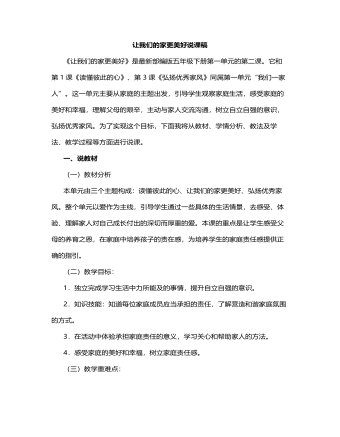
人教部编版道德与法制五年级下册让我们的家更美好说课稿
3.小结:我们要体谅家庭中的每个成员的辛劳,学会关心他们,支持他们,表达我们对家人的关爱。活动二:争当“智多星”1.生阅读教材阅读角内容2.交流讨论:妈妈为什么愁眉苦脸?她遇到了什么烦心事?我是如何帮助妈妈的?3.小结:生活中,家庭成员有困难,我们要留心观察、主动询问,尽力关心和帮助家人。有困难同商议,共承担。活动三:做好“润滑剂”过渡:日常生活中,家庭成员间很可能会产生纷争。当家人意见不统一时,我们该怎么办呢?1.教材第13页情景(1)看一看:家人之间发生了什么纷争?(2)议一议:你会如何来处理?2.说说生活中你的家庭中有什么困扰争论?3.小结当家人意见不一致是,我们可以和家人一起讨论,一起商量,发挥好“润滑剂”的作用,和家人一起面对困难解决问题。
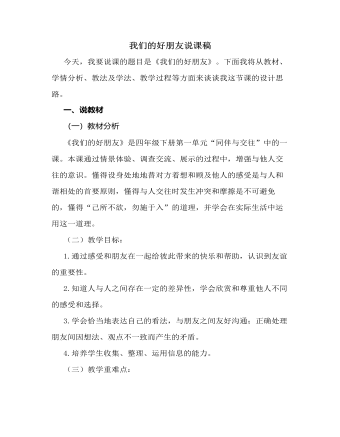
人教部编版道德与法制四年级下册我们的好朋友说课稿
教师:看呐,毛毛虫正在侵蚀着我们的友谊树,这些不利于友谊的行为我们统统拿掉。(摘掉友谊树上的毛毛虫卡片)教师:友谊树上终于结出了丰硕的果实。朋友之间,贵在理解,贵在沟通。只有这样,友谊之树才能茁壮成长。活动三:小小卡片传真情教师:朋友给予了我们那么多的帮助,带来那么多的快乐,你想对你的朋友说什么?请同学们把你想说的话填写在友谊卡片上。(学生制作卡并赠送卡片,采访收卡片同学。让学生认识什么是友谊,学会表达对同学的欣赏和友爱之情)教师:让我们再次对我们的好朋友说出那句真诚的话语,师生齐读:“我们的好朋友!”教师:《论语》“君子和而不同”,意思是君子在人际交往中,能够与他人保持一种和谐友善的关系,但在对具体问题的看法上却不必苟同于对方。人人都有自己的特点,不一样的朋友带给我们不一样的感受。希望同学们以后主动去结识更多的朋友,大家取长补短,共同进步。
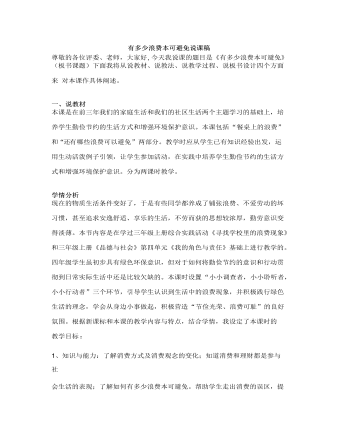
人教部编版道德与法制四年级下册有多少浪费本可避免说课稿
听完这些食物的哭诉,你有什么话想说? 3. 说一说:浪费有多种表现。 把不爱吃的食物扔掉是浪费;......是浪费; .....是浪费; ......是浪费。【设计理念】通过这些活动,让学生从身边小事入手,感受浪费现象无处不在。(二)算一算,想一想。1. 算一算:①用天平称一称,用小碗量一量,看看50 克大米有多少。②如果每个同学一天浪费50克大米,全班同学一天共浪费多少大米?一年共浪费多少?如果全校有500 个学生,一年将浪费多少大米?③一个学生一个月大约吃9 千克大米,如果能把这些被浪费的粮食积攒起来,可以 够多少学生吃一个月?2. 想一想:看到计算结果你有什么感受?【设计理念】让学生运用数学知识,计算出浪费的量,使学生明白这种浪费是容易 被忽视的,但日积月累就是一个很大的数目。
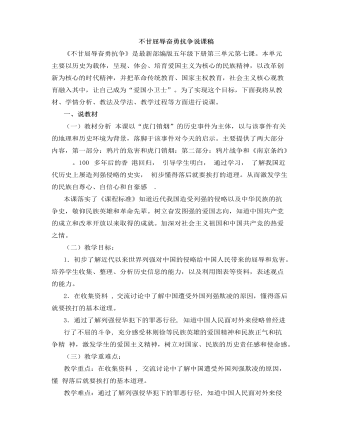
人教部编版道德与法制五年级下册不甘屈辱,奋勇抗争说课稿
师小结:气势恢宏的建筑,价值连城的奇珍异宝,不知凝聚着古今中外多 少能工巧匠的智慧和心血,因此,圆明园被誉为“万园之园”。活动二:惋惜圆 明园的毁灭1、令人遗憾的是,令人悲愤的是,这“万园之园”竟被一把无情的火烧成 了灰烬,那么,火烧圆明园是在什么情况下发生的呢?让我们看看当时的情景。师:这把无情的大火把我们引以为豪的“万园之园”烧成了一片灰烬,毁 于一旦。——板书:毁于一旦2、想一想,当时的圆明园为什么会被掠夺、焚烧?[ 出示课件 ] 南京条约的内容,用一个词来形容自己看到条约的心情。3.师:是的,只要是有良知的中国人看到这份条约都会感到无比的愤怒。 可是还有比这更令人愤怒的事,1900 年,八国联军侵入中国,你们知道他们都 干了些什么吗?4.圆明园如果存在于现在的中国,它还会遭到掠夺吗?为什么?(不会,因为中国强大了。)从哪可以看出中国强大了?(生自由说)
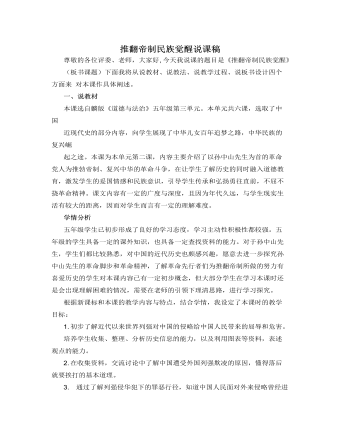
人教部编版道德与法制五年级下册推翻帝制,民族觉醒说课稿
孙中山先生一生都在为推翻帝制,推进民主革命,实现中华民族的伟大复 兴而努力,他是一位伟大的革命先驱,值待我们每个人的尊敬与怀念。 活动三:感受孙中山的革命精神(一)学习名言1、出示孙中山先生的名言,指名学生朗读。2、请学生来说说名言的含义。3、老师帮助解读,引导学生体悟孙中山先生的革命精神。4、请学生结合孙中山先生的伟大精神,说说对自己的学习生活的启示。5、齐读名言。(二)学习链接资料1、出示课文中链接资料,学生默读资料。2、讨论:说说我们国家目前的巨大变化,畅想祖国的美好未来。3、教师小结今日中华民族的伟大复兴与革命先辈们的不断探求救国救民之路,奋勇抗争推翻帝制是分不开的,让我们牢记历史,以孙中山等革命先驱为榜样,为祖国的美好未来努力奋斗!

人教部编版道德与法制六年级下册地球-我们的家园说课稿
一、说教材(一)教材分析本课是最新部编版《道德与法治》六年级下册第二单元第4课。本单元主要从爱护地球,保护环境的主题出发,引导学生从自己身边可触可感的资源出发,遵守相关法律法规,珍惜地球资源,自觉保护自然环境。本课主要讲地球提供人类生存的环境和资源,引导学生认识地球的唯一性,懂得地球是人类赖以生存的家园。树立珍惜地球资源、爱护环境的观念,并落实到行动中。(二)教学目标1.具有关爱自然的情感,形成保护环境的意识。2.初步理解人与自然、环境的相互依存关系;明白环境问题的严重性;知道保护环境是我们共同的责任。3.初步掌握收集、整理和运用信息的能力。(三)教学重难点教学重点:明白环境问题的严重性,形成保护环境的意识,养成保护环境的行为习惯。教学难点:形成保护环境的意识。
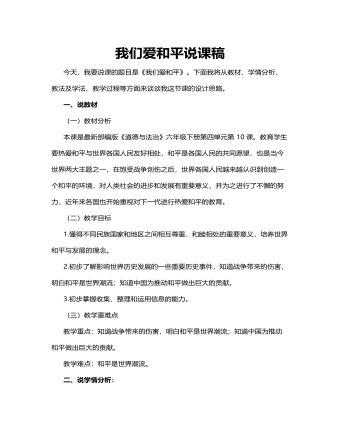
人教部编版道德与法制六年级下册我们爱和平说课稿
一、说教材(一)教材分析本课是最新部编版《道德与法治》六年级下册第四单元第10课。教育学生要热爱和平与世界各国人民友好相处,和平是各国人民的共同愿望,也是当今世界两大主题之一,在饱受战争创伤之后,世界各国人民越来越认识到创造一个和平的环境,对人类社会的进步和发展有重要意义,并为之进行了不懈的努力,近年来各国也开始重视对下一代进行热爱和平的教育。(二)教学目标1.懂得不同民族国家和地区之间相互尊重,和睦相处的重要意义,培养世界和平与发展的理念。2.初步了解影响世界历史发展的一些重要历史事件,知道战争带来的伤害,明白和平是世界潮流;知道中国为推动和平做出巨大的贡献。3.初步掌握收集、整理和运用信息的能力。(三)教学重难点教学重点:知道战争带来的伤害,明白和平是世界潮流;知道中国为推动和平做出巨大的贡献。教学难点:和平是世界潮流。
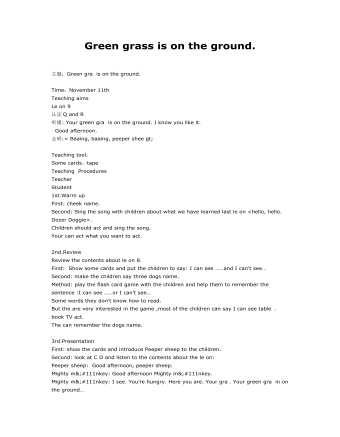
大班英语教案:Green grass is on the ground.
会唱:< Baaing, baaing,peeper shee gt; Teaching tool:Some cards、tape Teaching Procedures Teacher Student 1st.Warm up First: cheek name. Second: Sing the song with children about what we have learned last le on<hello, hello. Dozer Doggie>. Children should act and sing the song. Your can act what you want to act.
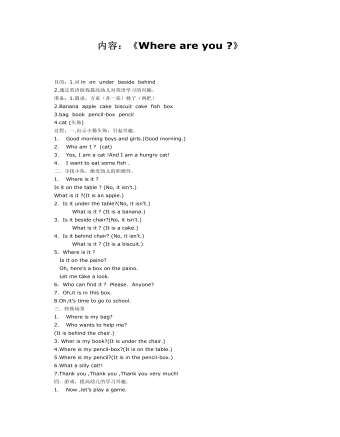
大班英语教案:Where are you
2.通过英语游戏提高幼儿对英语学习的兴趣。准备:1.圆桌,方桌(各一张)椅子(两把)2.Banana apple cake biscuit cake fish box 3.bag book pencil-box pencil4.cat (头饰)过程:一.出示小猫头饰,引起兴趣。1. Good morning boys andgirls.(Good morning.)2. Who am I ? (cat)3. Yes, I am a cat !AndI am a hungry cat!4. I want to eat somefish .二.寻找小鱼,激发幼儿的积极性。1. Where is it ?Is it on the table ? (No, it isn’t.)What is it ?(It is an apple.)2. Is it under the table?(No, it isn’t.) What is it ? (It is a banana.)3. Is it beside chair?(No, it isn’t.) What is it ? (It is a cake.)

人教版新目标初中英语八年级上册What’s the best radio station教案2篇
教学重点和难点:运用所掌握的语言描述,比较不同地点的特点。在练习中学习掌握英语比较级和最高级的用法。课前准备分配小组,每组五至六人。通过上网或翻阅报刊杂志等方法,确定旅游线路,做出基本的旅游计划。教学设计:本节课流程图 学法指导:1.由于这是一堂新课,在教学中应注意面向全体,发挥学生的主体性,引导学生积极参与,激发学生的求知欲和学习积极性,指导学生积极思维,主动获取知识,养成良好的学习方法。逐步学会独立解决问题。总之要尽可能调动学生的非智力因素促进智力因素的发展。教法选择:1.电化教学法2.课堂讨论法3.任务型教学法采用这些方法的目的是为了充分调动学生的学习积极性,使学生变被动学习为主动学习。通过电脑形象的演示,加强印象,提高兴趣,突破难点,提高教学效率,进而增大教学的容量和信息量。充分体现教师为主导,学生为主体的教学原则。

人教版新目标初中英语八年级上册What’s the matter教案2篇
She shouldn’t go to the party tonight.Step7. TaskT: You know, there are lots of problems in our life. If you are a doctor, please tell us how to solve the problem. I will divide you into 9 groups. Please work in groups. And then choose one of you to report your ideas.The following are the problems:I have a toothache.I am hungry. I have a sore throat.I am stressed out. I have a sore back.I am tired. I can’t sleep.I have a cold. I have a headache.Report: If you have a headache, you should go to bed early. You should see the doctor. You should eat some medicine. You shouldn’t wash your face with cold water.You shouldn’t sleep late.You shouldn’t swim.…..T encourages the students to give advice as much as possible.Homework:1. Chose one of the problems, and write down your advice2. Copy the new words这一步是用于热身的,同时也可以让他们复习一部分的表示人体部位的单词,扩充知识.学习语言的过程也是一个不断积累的过程,复习旧知识,增添新知识.通过小游戏,强化学生对Does she/he have…这个句子的运用能力.通过复习,自然的引到下面新知识的学习。充分利用表格,由句子到对话,再到文章,让学生循序渐进. 提高学生的综合语言运用能力,运用以前学过的知识来解决身边的问题.Period 5 (Section B 3a—3c, selfcheck)教学内容与分析:

人教版新目标初中英语八年级上册How do you make a banana milk shake教案2篇
1. First, ... then, ... next, ... finally, ...首先,……然后,……接着,……最后,……这是英语中表达做某事的步骤的一种说法。如果步骤较多,还可以说:first-next-after that-later on-finally/at last通常你会听到说英语国家的人在说 first, next, then, finally 和后面的内容时,他们会做一些停顿。这样就能提前告诉听者接下来讲的是一系列的步骤。这一点在朗读和听力中应特别注意。2. how many, how much均为疑问词,同是“多少”,但用法不同。请看:how many修饰可数名词复数,how much修饰不可数名词。但在用法上,同学们常犯如下错误:1) [误] How many are there bananas on the table?[正] How many bananas are there on the table?[析] how many, how much 中的many,much是形容词,常修饰名词作定语,故后面跟名词。2) [误]How much tea are there on the table?[正]How much tea is there on the table?[析] how much修饰不可数名词时,谓语动词用单数。how many与how much的区别可简记为:前how many:问“多少”,复数名词后面跑;how much问“多少”,不可数名词单数好。前者答语用基数词,后者答语用数量关系。

人教版新目标初中英语八年级上册How was your school trip教案2篇
“Go for it!” is based on “Task-Based Language Teaching”. It adheres to “The authenticity principle”, “The form-function principle”, “The task dependency principle” and “The principle of learning by doing”. These principles all accord with the demands of curriculum focus.In and of Grade Seven (II), “Go for it!”, students have learned “The Simple Past Tense”. And it appears again in of Grade Eight (I). teaches students more about how to talk about events in the past. In addition, it gives affirmative and negative statements in the past tense, such as the sentence patterns “Did you see …?” “Were there …?” “Did you go …?” As the first part of Unit 8, Section A opens with a picture presenting the last school trip in the aquarium and continues with several step-by-step practice activities, which are all good for students to master “The Simple Past Tense”. Doing well in Section A will help students integrate the new target language with that in Section B. Thus, they can describe the events in the past freely and foster their own ability of reflecting and practicing. II. Teaching ObjectivesTeaching objective is the beginning and aim of teaching activities. According to the overall goal of the English elementary course--- improve students' synthetic ability of language application, which should be based on the development of students’ “Language knowledge”, “Language skills”, “Character building”, “Learning strategies” and “Cross-cultural awareness”. The teaching objectives are described as follows(I). Knowledge objectivesi. Master the simple past tense of regular and irregular verbsii. Recite the new words and expressions about the last school trip in the aquarium, including their pronunciation and intonation

人教版新目标初中英语八年级上册How do you get to school教案2篇
Step Ⅶ Role play ( Work on 1b)1. First ask two students to read the dialogue to the class.Sa: How do you get to school?Sb: Well, I ride my bike to the subway station. Then I take the subway.2. Now work with a partner.Suppose you use two kinds of transportation to get to school \Hangzhou\Beijing... (bus, train, subway, walking, bike, etc.) Tell how you get there. You may use the phrases in 1a.3. Then ask different pairs of students to present their conversations to the class.Step ⅧListening1. Work on 2a(1) First ask students to read the list of information that Thomas wants to know.…where Nina lives.…how far from school she lives.…how long it takes to get to school.…how she gets to school.…what she thinks of the transportation.(2) Tell students what transportation and bus stop mean.bus stop 汽车站 transportation n. 运送;运输Then tell students we'll hear a recording. Please put a checkmark in front of each thing that Thomas wants to know.(3) Now play the recording for students.( Have students pay attention to the sample answer.) (4) Then correct the answers.

人教版新目标初中英语八年级上册What are you doing for vacation教案2篇
Teaching goals : 1. Words & phrases: babysit ,get back , fishing , rent , think about , decide(on) , tourist etc. 2. How to talk about future plans . 3. 现在进行时表示将来计划或行动. 4. 特殊疑问句(where , when , how long引导) Important and difficult points : Drills :What are you doing for vacation ? I’m watching TV . When are you going ? I’m going … . How long are you staying ? We’re staying for five days . Teaching aids : cards and a tape ,a large wall calendar . Period 1 Teaching procedures : Step 1Leading in1. Free talk . 2. Put up the wall calendar . T: I’m staying home on Saturday (pointing to next Saturday ).Ss repeat . Ss: I’m staying home on Saturday . T: OK. Today we’ll learn how to talk about future plans. Step 2Pre-task SB Page 13 , 1a . 1. Look at the picture carefully and tell what you see in the picture . 2. Write the activities from the pictures in the box and add some more . 3. Practice reading . Step 3While-task1. Using the activities we write in 1a to make conversations .For example :What are you doing for vacation ? I’m visiting my uncle . 2. Pairwork .Practice in pairs . 3. 用第三人称练习对话.

人教版新目标初中英语九年级上册Teenagers should be allowed to choose their own clothes教案2篇
Step 1 Greeting Greet the class and check the homeworkStep 2 A duty report The S on duty gives a report on the rules in his home and lead in 3a “Sun Fei’s and Wu Yu’s rules” Step 3 ReadingSs read the conversation and write the two girls’ rules in the chart. Check the answers.Get Ss to read after the tape and then read aloud by themselves. Then, T explains the language points.Step 4 Pairwork 3bRole play. Use the information in chart to practice with the conversation in 3a covered. They can look at the sample conversation in the right box.Step 5 Task 2 “Who’s the best reporter?”Make a survey by asking any 5 students the questions in the chart in activity 4. Then give out a report about it. See who is the best reporter? And the best reporter will get a nice ball-pen.Step 6 Summary and homework:Write out the report in your exercise-books.Period ThreeStep 1 Greeting and a duty reportThe S gives a duty report talking about his experience of being late for school. Lead in the question “Do you ever get to school late? How often do you get to school late? Always, usually, sometimes, or never?Step 2 1a Get Ss to finish writing.Step 3 Pairwork 1b Get Ss to talk about their answers with their partners using the sample conversation in the box on the right.Step 4 Listening practice2a Lead-in: What will happen if you get to school late? What about Peter? Let’s listen to a conversation between Peter and his father. Get Ss to finish 2a (As usual, for the first time, Ss only listen.) Check the answers.

人教版新目标初中英语九年级上册How do you study for a test教案2篇
内容提示本单元主要内容是学会利用verb十by/with gerund表示方式方法来讨论学习英语的策略,认识自己在学习方面的长处和不足。初步了解现在完成时的结构和用法。现在完成时由助动词have/has+动词的过去分词构成,主要表示过去发生的某一动作对现在仍有影响或造成的后果,常与already,yet,just,ever,never等副词连用。教学目标一、学习目标(Language Goal) 1. Talk about how to study . 学会讨论各种学习方法和策略。2. Find out your suitable learning methods. 找出适合自己的学习方法。 二、语言结构(Language Structures) 1. Verb + by with gerund by+动名词短语 表示“通过…途径,方法” 2. How questions have引导的特殊疑问句 三、目标语言(Target Language) 1. How do you study for tests ? 你是怎样准备考试的?Well , I study by working with my classmates. 哦,我和同学们一起学习。2. Have you ever studied with a group ? 你曾经参加过学习小组吗?Yes , I have . I’ve learned a lot that way . 是的,参加过。通过这种方式我学了许多。
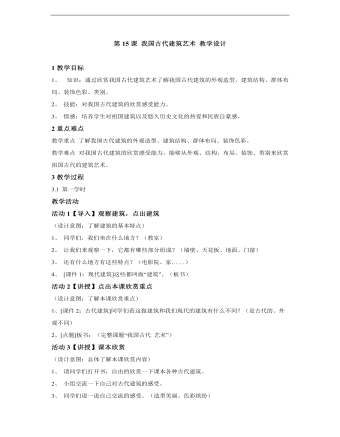
小学美术人教版六年级下册《第15课我国古代建筑艺术》教学设计说课稿
2重点难点教学重点了解我国古代建筑的外观造型、建筑结构、群体布局、装饰色彩。教学难点对我国古代建筑的欣赏感受能力,能够从外观、结构、布局、装饰、类别来欣赏祖国古代的建筑艺术。3教学过程3.1 第一学时教学活动活动1【导入】观察建筑,点出建筑(设计意图:了解建筑的基本特点)1、同学们,我们坐在什么地方?(教室)2、让我们来观察一下,它都有哪些部分组成?(墙壁、天花板、地面、门窗)3、还有什么地方有这些特点?(电影院、家… …)4、 [课件1:现代建筑]这些都叫做“建筑”。(板书)
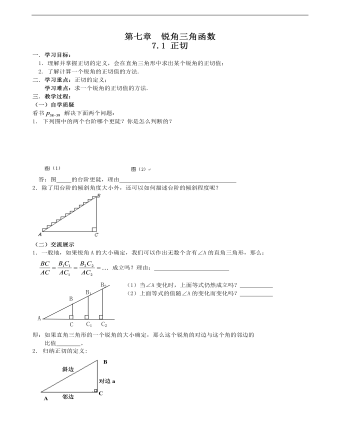
初中数学苏科版九年级下册《71正切》说课稿
(一)自学质疑看书 解决下面两个问题:1.下列图中的两个台阶哪个更陡?你是怎么判断的? 答:图 的台阶更陡,理由 2.除了用台阶的倾斜角度大小外,还可以如何描述台阶的倾斜程度呢?
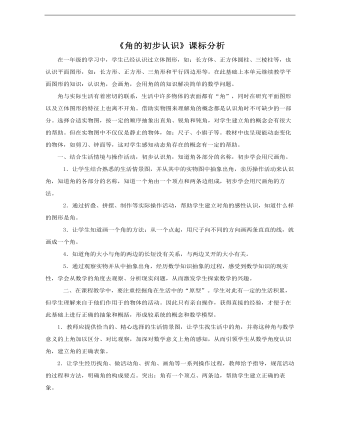
小学数学青岛版二年级上册《角的初步认识》课标分析说课稿
一、结合生活情境与操作活动,初步认识角,知道角各部分的名称,初步学会用尺画角。 1.让学生结合熟悉的生活情景图,并从其中的实物图中抽象出角,亲历操作活动来认识角,知道角的各部分的名称,知道一个角由一个顶点和两条边组成,初步学会用尺画角的方法。 2.通过折叠、拼摆、制作等实际操作活动,帮助学生建立对角的感性认识,知道什么样的图形是角。 3.让学生知道画一个角的方法:从一个点起,用尺子向不同的方向画两条直直的线,就画成一个角。 4.知道角的大小与角的两边的长短没有关系,与两边叉开的大小有关。 5.通过观察实物并从中抽象出角,经历数学知识抽象的过程,感受到数学知识的现实性,学会从数学的角度去观察、分析现实问题,从而激发学生探索数学的兴趣。 二、在课程教学中,要注重挖掘角在生活中的“原型”。学生对此有一定的生活积累,但学生理解来自于他们作用于的物体的活动。因此只有亲自操作,获得直接的经验,才便于在此基础上进行正确的抽象和概括,形成较系统的概念和数学模型。1.教师应提供恰当的、精心选择的生活情景图,让学生找生活中的角,并将这种角与数学意义的上角加以区分、对比观察,加深对数学意义上角的感知,从而引领学生从数学角度认识角,建立角的正确表象。